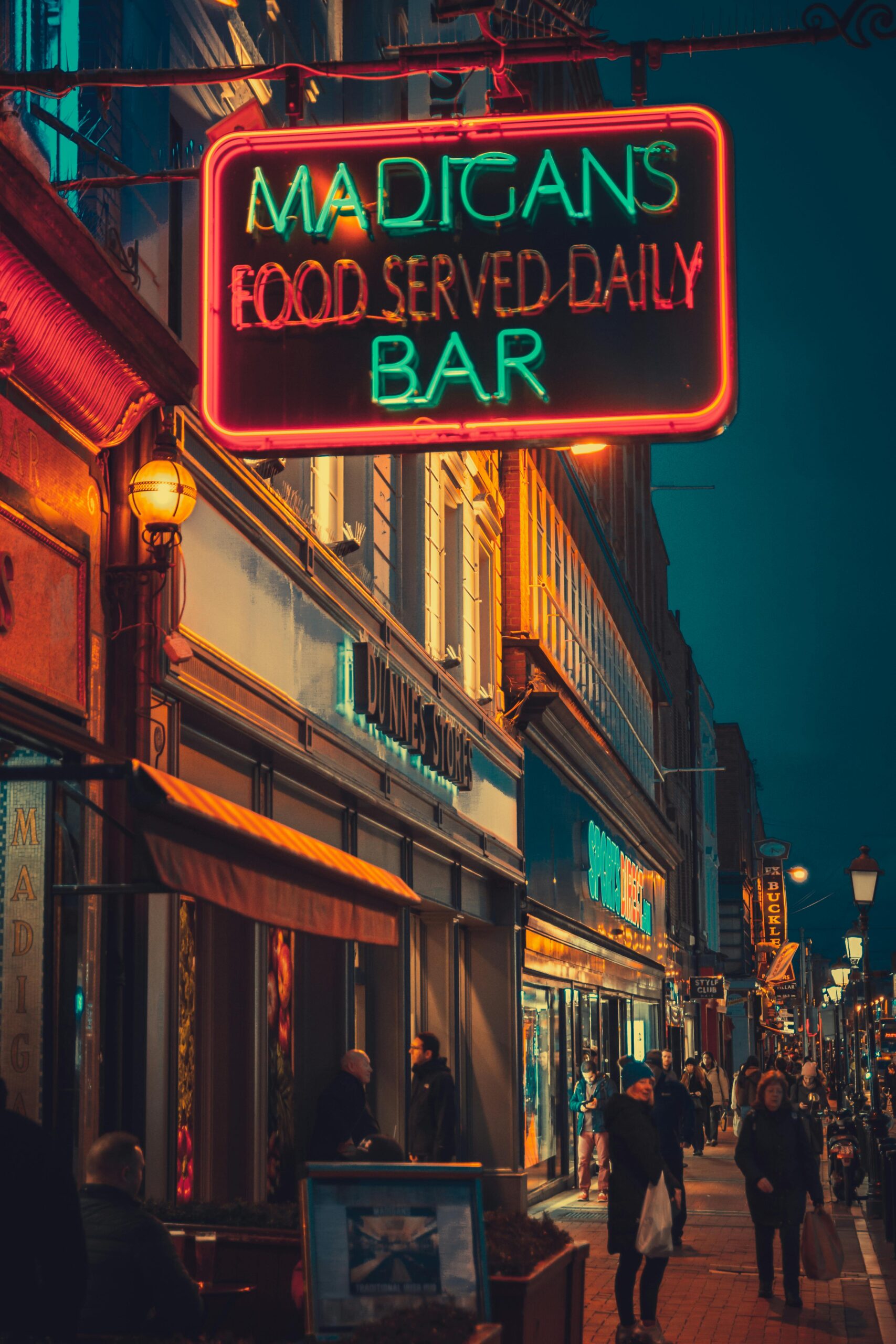Exploring a Dublin map is like unlocking a treasure chest full of hidden gems and secrets tucked away in Ireland’s vibrant capital. Are you ready to discover the lesser-known spots that even some locals might miss? This guide will take you beyond the usual tourist trails, revealing secret locations in Dublin, charming alleyways, and historical nooks that make the city truly unforgettable. Whether you’re a first-time visitor or a seasoned explorer, navigating Dublin through an insightful map can unveil a whole new side to this iconic city.
Dublin is more than just the famous landmarks like Trinity College or the Guinness Storehouse. With the help of a detailed interactive Dublin map, you can dive deep into the heart of the city’s culture, uncovering quirky cafes, hidden pubs, and stunning street art that tells stories of Ireland’s rich heritage. Have you ever wondered where to find the most Instagrammable spots or the best-kept secrets of Dublin’s nightlife? This article will guide you through these must-visit places, ensuring your adventure is packed with surprises and authentic experiences.
Using a Dublin city map with hidden gems is the perfect way to plan your trip off the beaten path. From secret gardens to underground music venues, the capital is bursting with treasures waiting to be explored. So why stick to the usual routes when you can experience Dublin like a true insider? Keep reading to discover how a carefully curated Dublin map can transform your visit into an unforgettable journey full of mystery, charm, and excitement.
Unearthing Dublin’s Hidden Gems: Top 7 Secret Spots Off the Beaten Path on Your Dublin Map
Unearthing Dublin’s Hidden Gems: Top 7 Secret Spots Off the Beaten Path on Your Dublin Map
Dublin, Ireland’s vibrant capital, have much more to offer than the usual tourist hotspots like Trinity College or Temple Bar. If you think you knows Dublin well, think again. The city is full of secret places, tucked away from the crowds, waiting to be discovered. Using a detailed Dublin map, you can explore these hidden gems that reveal a different side of the city, blending history, culture, and local charm in ways the guidebooks rarely mention. Here’s a list of the top 7 secret spots off the beaten path you should add to your Dublin itinerary.
1. The Blessington Street Basin
Often overlooked by visitors, the Blessington Street Basin is a peaceful, historic reservoir turned public park. Built in 1810, it was originally one of Dublin’s main water sources. Today, it’s perfect for a quiet stroll or a picnic, surrounded by beautiful greenery and old stone walls. It’s a great way to escape the busy city centre, and you will find locals walking their dogs or reading on benches.
- Location: Blessington Street, near the North Circular Road
- Highlights: Historic water basin, peaceful gardens, birdwatching opportunities
- Best time to visit: Spring and summer for full bloom
2. The Little Museum of Dublin
This small museum near St Stephen’s Green is packed with quirky exhibits about Dublin’s 20th-century history. Unlike larger museums, it focuses on everyday life and local stories, showcasing objects donated by Dubliners themselves. It’s a perfect spot for those who want to understand the city beyond the usual landmarks.
- Location: 15 St Stephen’s Green
- Exhibits include: Vintage postcards, old radios, Beatles memorabilia related to Dublin
- Guided tours available, often by enthusiastic locals
3. Marsh’s Library
Right beside St Patrick’s Cathedral, Marsh’s Library is a rare surviving example of an early 18th-century library. It hasn’t changed much since it opened in 1707, with wooden shelves filled with ancient books, some dating back to the 15th century. It’s like stepping back in time, and it’s surprisingly quiet considering its central location.
- Location: St Patrick’s Close
- Unique feature: Original catalogue system still in use
- Ideal for: History buffs and book lovers
4. The Cobblestone Pub in Smithfield
While pubs are everywhere in Dublin, The Cobblestone is a genuine gem for traditional Irish music. It’s less touristy than Temple Bar bars, and locals come here for authentic sessions that happen almost every night. The atmosphere is lively, but not overwhelming, and the bartenders are friendly and knowledgeable.
- Location: 77 King Street North, Smithfield
- Known for: Live traditional music, cozy interiors, excellent Irish whiskey selection
- Tip: Arrive early on weekends to get a good seat
5. The Irish Jewish Museum
Hidden in the Portobello area, this museum tells the story of the Jewish community in Dublin, which dates back to the 18th century. The exhibits cover cultural traditions, immigration stories, and important contributions to Irish society. It’s a small but deeply moving museum.
- Location: 3 Walworth Road, Portobello
- Exhibits: Historic photographs, ritual objects, personal stories
- Admission: Usually small fee, worth it for the unique perspective
6. The Casino at Marino
Don’t confuse this with a gambling venue. The Casino at Marino is a tiny neoclassical building built in the 18th century, located just outside the city centre. It was designed as a garden retreat for the Earl of Marino and is renowned for its clever architectural tricks. Despite its small size, it has 16 rooms, many of which are hidden or disguised.
- Location: Marino, north Dublin
- Architectural marvel: Intricate design, secret doors, optical illusions
- Open seasonally, check times before visiting
7. The Hellfire Club on Montpelier Hill
For those who want something a bit spooky, the Hellfire Club ruins are a must-see. This 18th-century hunting lodge is infamous for legends about secret societies and ghost stories. It’s perched on Montpelier Hill, offering panoramic views of Dublin and the Wicklow Mountains. The hike up is a bit challenging but rewarding.
- Location: Montpelier Hill, near Rathfarnham
- What to expect: Ruined building, eerie atmosphere, great views
- Bring: Good walking shoes and maybe a torch if you visit late
Using a Dublin map to navigate these spots will give you a richer experience than just sticking to the usual tourist trail. Each place has its own story and character, revealing facets of Dublin’s history and culture that many miss. Whether you’re
How to Navigate Dublin Like a Local: Insider Tips for Exploring Ireland’s Capital with a Detailed Dublin Map
How to Navigate Dublin Like a Local: Insider Tips for Exploring Ireland’s Capital with a Detailed Dublin Map
Dublin, the vibrant capital of Ireland, is a city full of history, culture, and lively streets that promise plenty of adventures. But if you want to see beyond the usual tourist traps and really feel the pulse of the city, you need more than just a standard guidebook. A detailed Dublin map combined with some local know-how can transform your visit from ordinary to unforgettable. Whether you been to Dublin before or it’s your first time, navigating the city like a local will give you unique perspectives and uncover hidden gems most visitors miss.
Why A Detailed Dublin Map Makes a Difference
Many travelers think a map is just for finding their way from A to B. But Dublin maps, especially ones that highlight lesser-known lanes, parks, and historical sites, can be your best friend. Dublin’s layout is a mix of old and new, with winding cobbled streets alongside modern buildings. Without a good map, it’s easy to get lost or miss out on the charm that hides in small alleys or quiet neighbourhoods.
For example, the famous River Liffey splits the city in two, but just exploring north or south independently might leave you unaware of some fascinating spots on either side.
Key Areas On Your Dublin Map To Explore Like A Local
- Temple Bar: Often crowded but still a must visit for its lively atmosphere, street performers, and pubs. Try to explore early morning when it’s quieter.
- Stoneybatter: A trendy neighbourhood west of the city centre where locals hang out. Full of cafés, vintage shops, and street art.
- Smithfield: Known for the old Jameson Distillery and a growing food scene. Less touristy and great for evening strolls.
- The Liberties: One of Dublin’s oldest quarters, full of history, markets, and traditional pubs.
- Howth: Just outside the city, accessible by DART train, this fishing village offers coastal walks and fresh seafood.
Hidden Gems You Probably Didn’t Know About
There are plenty of spots that don’t make it onto regular tourist maps but are beloved by Dubliners:
- Marsh’s Library: A beautiful 18th-century library near St Patrick’s Cathedral that feels like stepping back in time.
- The Irish Jewish Museum: Located in Portobello, it tells the story of the Jewish community in Ireland.
- Merrion Square Park: Famous for its statues of Oscar Wilde and lovely gardens, it’s a peaceful retreat from the busy city life.
- The Blessington Street Basin: A hidden water reservoir-turned-park with ducks and walking paths.
- Secret alleyways in the Georgian Quarter: These often-overlooked streets show off Dublin’s elegant architecture.
Tips For Using Your Dublin Map Effectively
- Don’t just use it for navigation. Mark spots that interest you, maybe cafes or bookshops you want to pop into.
- Combine with apps like Google Maps or Citymapper for public transport info. Dublin buses and trams (Luas) cover wide areas.
- Look for free walking tours that use detailed maps. They’re a great way to learn stories behind the buildings.
- Use different maps for different interests: one for food lovers, another for history buffs, and one for nightlife.
- Always have a physical copy handy. Phone batteries die, and sometimes mobile signals are patchy in some older parts of the city.
Comparing Dublin’s Map With Other European Capitals
Compared to cities like London or Paris, Dublin is smaller and more walkable, but it has its own quirks. The streets don’t follow a strict grid pattern like Manhattan, which means good maps become essential. In Paris, main attractions are well signposted, but in Dublin, many cultural treasures are tucked away and need a bit more effort to find.
Transportation-wise, Dublin relies heavily on buses and the Luas tram system, but taxis and bike rentals also help you cover ground quickly. Unlike some capitals, cycling isn’t always easy due to cobbled streets and narrow lanes, so plan your route carefully.
Practical Example: A Day Navigating Dublin Like a Local
Here’s a simple itinerary to use your Dublin map and explore hidden gems:
- Start at Merrion Square Park to enjoy the morning calm and see the Oscar Wilde statue.
- Walk to the nearby Marsh’s Library, spend half an hour exploring the old books.
- Head west towards Stoneybatter, stop for brunch in a local café.
- Wander through the Georgian streets nearby, mapping out the colourful doors and architecture.
- Take the Luas tram down to Smithfield for some afternoon drinks and maybe visit the Jameson Distillery.
- Finish your day with a stroll along the River Liffey at sunset,
Discover Dublin’s Best-Kept Secrets: Must-See Attractions and Hidden Corners Revealed
Discover Dublin’s Best-Kept Secrets: Must-See Attractions and Hidden Corners Revealed
If you think Dublin is only about the well-known Trinity College, Guinness Storehouse, and Temple Bar, you could be missing out on so much more. This city, rich in history and culture, holds many secrets tucked away from the usual tourist maps. The Dublin map is not just about big landmarks; it’s dotted with hidden gems that offers a unique experience to those willing to explore beyond the obvious. Whether you are a local or a visitor from New York, uncovering Dublin’s lesser-known treasures can be quite rewarding.
Dublin Map: Discover Hidden Gems and Secrets of Ireland’s Capital
Dublin’s layout can be a bit confusing at first, but with a good map and some curiosity, you can find spots that many never notice. Some places are small, tucked in narrow streets or behind old facades, others are parks or quiet corners with a story to tell. Here’s a guide to some secret spots and must-see attractions that don’t usually feature in typical travel brochures.
Must-See Hidden Attractions
-
Marsh’s Library
- Location: St Patrick’s Close
- Why visit: Opened in 1707, it’s one of the oldest public libraries in Ireland. The shelves still hold ancient manuscripts and books, and the atmosphere is like stepping back in time.
- Fun fact: The library survived the 1916 Easter Rising and remains largely unchanged.
-
The Casino at Marino
- Location: Marino, north Dublin
- Why visit: It’s a tiny 18th-century neoclassical building, designed as a pleasure house by the architect Sir William Chambers. It looks small outside but inside, the rooms are cleverly designed to maximise space.
- Historical note: Despite its name, it was never used for gambling.
-
The Little Museum of Dublin
- Location: St Stephen’s Green
- Why visit: Unlike big museums, this one tells the 20th-century story of Dublin through quirky artefacts donated by locals. It’s a charming peek at Dublin life from 1900s to modern day.
- Interactive exhibits often include old photographs, costumes, and even a Beatles memorabilia.
Quiet Corners and Green Spaces
- St Anne’s Park: This large park in Raheny often overlooked by visitors, offers beautiful rose gardens, walking trails, and a peaceful lake. It’s perfect for a picnic or a quiet afternoon away from city noise.
- The Blessington Street Basin: A former city reservoir turned into a lush park space. It’s great for bird watchers and those who appreciate urban nature.
- Iveagh Gardens: Sometimes called Dublin’s secret garden, it’s less crowded than the famous Phoenix Park yet just as lovely with fountains, maze, and Victorian-style landscaping.
Dublin’s Secret Streets and Alleys
The city’s charm often lies in its small lanes and hidden streets where you find cafes, vintage shops or street art that tells a story. Here’s a few to add on your Dublin map:
- Catherine Street: A narrow street with colourful doors and quirky shops.
- Drury Street: Known for its pubs and a bit of alternative nightlife away from the tourist crowds.
- Merrion Row: Close to the National Gallery but often forgotten by visitors, filled with Georgian architecture and quiet cafes.
Comparing Dublin’s Famous Spots and Hidden Gems
| Aspect | Famous Attractions | Hidden Gems |
|---|---|---|
| Crowd Levels | Usually very busy, especially during summer | Quiet and peaceful, less crowded |
| Admission Fees | Often require tickets or entry fees | Many are free or ask for small donations |
| Historical Depth | Broad overview of Irish history | Specific stories and unique perspectives |
| Atmosphere | Tourist-friendly, sometimes commercial | Authentic, local feel |
| Accessibility | Easy to find on main routes | Require some walking and exploration |
How to Use a Dublin Map to Find Hidden Gems
When you get a Dublin map, do not just stick to the main roads or famous landmarks. Try marking the less obvious locations and plan a walk or cycle route around them. Ask locals for tips because sometimes the best secrets aren’t in any guidebook. Practical tips include:
- Download offline maps to avoid data costs.
- Use apps that highlight walking trails and historic spots.
- Visit local tourist offices for free maps with hidden gems marked.
- Combine visits to famous sites with nearby lesser-known spots to enrich your experience.
A Few Practical Examples of Itineraries Mixing Secrets and Classics
- Morning: Start at Trinity College to see the Book of Kells, then walk to Marsh’s Library nearby.
The Ultimate Guide to Dublin’s Historic Landmarks and Hidden Treasures on Your Interactive Dublin Map
Exploring Dublin is like stepping into a living storybook filled with tales of kings, poets, rebels, and dreamers. But with so many landmarks and secret spots scattered across the city, knowing where to begin can be a bit overwhelming. That’s where your interactive Dublin map comes in handy — it’s not just a guide, but a key to unlocking the hidden gems and historic treasures of Ireland’s capital. Whether you’re a first-time visitor or a local wanting to rediscover the city, this ultimate guide will help you navigate Dublin’s rich past and lesser-known delights.
Dublin Map: More Than Just Streets and Squares
Most people think a Dublin map only shows roads and famous landmarks like Trinity College or Dublin Castle. But an interactive Dublin map is different. It reveals secret laneways, tucked-away pubs, forgotten statues and even folklore spots that many miss. By using layers and filters, you can discover places by category — such as historical sites, cultural venues, or quirky attractions. It’s like having a local expert in your pocket, ready to show you the city from a fresh perspective.
Historic Landmarks You Can’t Miss
Dublin’s history is layered and complex, stretching back more than a thousand years. The landmarks tells stories of Viking invasions, medieval bishops and revolutionary heroes. Here are some essentials to mark on your map:
-
Dublin Castle
Originally built in 1204, Dublin Castle served as the seat of British rule in Ireland for centuries. Today it’s a government complex and a tourist attraction, where you can explore the State Apartments and medieval undercroft. -
Christ Church Cathedral
One of Dublin’s oldest buildings, Christ Church dates from the early 11th century. Its crypt is one of the largest in Britain and Ireland and houses fascinating artefacts. -
Kilmainham Gaol
This former prison played a major role in Irish history, especially during the 1916 Easter Rising. Tours here give a sobering look at Ireland’s fight for independence. -
Ha’penny Bridge
The elegant cast iron pedestrian bridge over the River Liffey is more than just a crossing — it symbolises Dublin’s urban development in the 19th century.
Discover Hidden Gems Using Your Interactive Dublin Map
Beyond the well-trodden paths, Dublin harbours many secrets. Your map lets you zoom into neighbourhoods and uncover places that rarely make guidebooks. Here are some treasures you might find:
-
Marsh’s Library
Tucked beside St Patrick’s Cathedral, it is one of the oldest public libraries in Europe. The dusty shelves and original oak desks make you feel like you stepped back in time. -
The Little Museum of Dublin
A quirky spot that tells Dublin’s 20th-century story through artefacts donated by locals. It’s small but packed with character. -
The Blessington Street Basin
This peaceful urban pond was once a reservoir supplying water to the city. Now it’s a favourite for bird watchers and families. -
The Casino at Marino
A neoclassical gem hidden in a suburb, this tiny 18th-century building is an architectural marvel full of clever tricks and illusions.
Table: Comparing Dublin’s Top Historic Sites
| Landmark | Built | Significance | Admission Fee | Accessibility |
|---|---|---|---|---|
| Dublin Castle | 1204 | Seat of British administration | Yes | Wheelchair accessible |
| Christ Church Cathedral | Early 11th C | Religious and medieval heritage | Yes | Limited accessibility |
| Kilmainham Gaol | 1796 | Irish independence history | Yes | Not fully accessible |
| Ha’penny Bridge | 1816 | Iconic pedestrian bridge | Free | Fully accessible |
Why Using an Interactive Dublin Map Changes Everything
A paper map or a basic GPS app only gets you so far. An interactive Dublin map are powered by real-time updates, user reviews and multimedia guides. You can:
- Filter by interests like history, food, street art, or shopping
- Read local tips about best times to visit or hidden entrances
- See photos and videos before you arrive
- Plot walking routes combining famous and obscure stops
For example, if you want a day focused on literary Dublin, your map can guide you from the James Joyce Centre to the Poet’s Corner in St Patrick’s Cathedral, with stops at pubs where Yeats and Beckett used to drink. Or for a family day, it highlights playgrounds, parks, and kid-friendly museums.
Practical Tips for Navigating Dublin’s Historic and Hidden Spots
- Wear comfortable shoes — many of Dublin’s best streets are cobbled or uneven
- Check opening hours in advance; some historic sites close early or have seasonal schedules
Why Every Traveller Needs a Dublin Map: Unlocking Ireland’s Capital’s Hidden Wonders and Secret Routes
Why Every Traveller Needs a Dublin Map: Unlocking Ireland’s Capital’s Hidden Wonders and Secret Routes
Dublin is one of those cities that has a personality you can’t really understand from a simple guidebook or a quick online search. It’s not just about the famous landmarks like Trinity College or the Guinness Storehouse. No, there’s so much more to discover if you got a proper Dublin map in your hand. People often think that smartphones and GPS apps make maps obsolete, but the truth is, a physical or detailed digital Dublin map helps you uncover hidden gems and secret routes that many travellers miss. This article explores why every traveller really needs some form of Dublin map to get the most out of their visit to Ireland’s bustling capital.
Why a Dublin Map is Essential for Exploring the City
Dublin is a city of layers, with each street and alley whispering stories from centuries ago. Without a map, you could easily get stuck in the typical tourist traps and miss out on the authentic experiences. A good Dublin map will show you not only the main attractions but also those lesser-known places where locals hang out.
Some reasons why a Dublin map is a must-have:
- Helps you locate off-the-beaten-path spots not well marked on standard GPS apps
- Guides you through historic neighbourhoods like Temple Bar, but also quieter areas like Stoneybatter
- Shows walking routes that avoid busy roads and reveal beautiful architecture or street art
- Assists in planning efficient routes to maximise your time and avoid backtracking
- Provides context with historical notes and points of interest, enriching your visit
Discover Hidden Gems and Secrets of Ireland’s Capital
Dublin’s charm lies in its mix of old and new. While many tourists flock to the obvious places like Dublin Castle or the National Museum of Ireland, a map can lead you to some secret treasures. For example, did you know about the tucked-away gardens behind Merrion Square, or the ancient Viking walls near Wood Quay? Without a detailed Dublin map, these spots might stay hidden.
Here are a few hidden gems that a good Dublin map highlights:
- The Little Museum of Dublin: A quirky museum telling the story of 20th-century Dublin through objects donated by locals
- Marsh’s Library: One of the oldest public libraries in Ireland with beautiful wooden interiors and rare books
- St. Michan’s Church crypts: A chilling but fascinating place where mummified bodies are preserved underground
- The cobbled streets of the Liberties: An area rich with history and artisan shops, often overlooked by tourists
- The serene Blessington Street Basin: A peaceful, lesser-known park perfect for a quiet stroll
Historical Context You Can’t Get Without a Map
Dublin’s history spans over a thousand years, from its Viking origins to its role in Ireland’s fight for independence. Many street names, monuments and building styles are tied to this rich past. A Dublin map that includes historical context helps visitors visualise how the city evolved.
For instance, the layout of streets like Dame Street and Fishamble Street dates back to medieval times. The Dublin map can pinpoint where significant events happened: the 1916 Easter Rising, the construction of Georgian squares, or the locations of famous literary figures like James Joyce and W.B. Yeats.
Comparing Dublin Maps: Paper vs Digital
Travellers nowadays have options when it comes to maps. But each type has its pros and cons:
Paper Dublin Maps
- Tangible and easy to annotate with notes or highlights
- No battery or signal issues
- Often includes detailed walking trails and historical info
- Can get damaged or lost easily
Digital Dublin Maps (Apps, PDFs)
- Constantly updated with new info and user reviews
- Can integrate GPS for real-time location tracking
- Allows quick searching and route planning
- Sometimes less detailed about hidden gems or history
For those wanting to fully unlock Dublin’s secrets, a combination of both is often best. A paper map for exploring on foot and a digital one for quick references or public transport planning.
Practical Tips for Using Your Dublin Map
Getting a Dublin map is just the start. Here’s how to make the most of it:
- Mark your accommodation and nearby landmarks – helps orient yourself quickly
- Plan a few walking routes before heading out – include a mix of main attractions and hidden spots
- Use the map to spot good places for meals or coffee away from tourist crowds
- Keep it handy but protected – a waterproof cover or a digital backup can save the day
- Ask locals for recommendations and then check the map to find these places – often locals know secret spots not in guidebooks
Dublin Map Sample Itinerary Outline
To give you an idea of what a map-guided day in Dublin looks like, here’s a rough itinerary that mixes famous sights with hidden gems:
| Time | Activity
Conclusion
In conclusion, a detailed Dublin map is an invaluable tool for both visitors and locals alike, offering clear navigation through the city’s diverse neighbourhoods, historic landmarks, and vibrant cultural spots. Whether exploring the bustling streets of Temple Bar, admiring the grandeur of Trinity College, or finding your way to the scenic banks of the River Liffey, having an accurate and up-to-date map enhances your experience significantly. Additionally, with the integration of digital maps and mobile apps, discovering hidden gems and planning efficient routes has never been easier. Embracing these resources not only saves time but also enriches your understanding of Dublin’s rich heritage and dynamic atmosphere. So, whether you’re planning a day trip or a longer stay, make sure to equip yourself with a reliable Dublin map – your perfect companion for uncovering everything this remarkable city has to offer.








